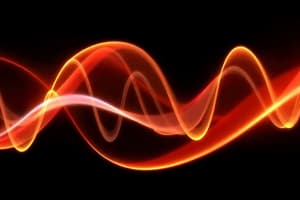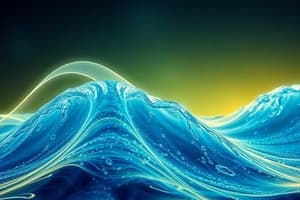Podcast
Questions and Answers
What are the main information-carrying molecules of the cell?
What are the main information-carrying molecules of the cell?
- Lipids
- Proteins
- Nucleic acids (correct)
- Carbohydrates
What are the two main classes of nucleic acids?
What are the two main classes of nucleic acids?
- Deoxyribonucleic acid (DNA) and ribonucleic acid (RNA) (correct)
- Polysaccharides and disaccharides
- Polypeptides and polynucleotides
- Purines and pyrimidines
What are the monomers of nucleic acids?
What are the monomers of nucleic acids?
- Amino acids
- Nucleotides (correct)
- Fatty acids
- Monosaccharides
What is the general equation for a combination reaction?
What is the general equation for a combination reaction?
What is the opposite of a combination reaction?
What is the opposite of a combination reaction?
What type of reaction involves the exchange of ions between two reactants?
What type of reaction involves the exchange of ions between two reactants?
What is the product of a combustion reaction involving oxygen and a hydrocarbon?
What is the product of a combustion reaction involving oxygen and a hydrocarbon?
What are the monomers of proteins?
What are the monomers of proteins?
What are the polymers of carbohydrates?
What are the polymers of carbohydrates?
What are the elements that comprise nucleic acids?
What are the elements that comprise nucleic acids?
Flashcards are hidden until you start studying
Study Notes
Types of Waves
- Electromagnetic waves (EM waves) are created by vibrations between electric and magnetic fields
- Mechanical waves require a medium to propagate
Electromagnetic Waves
- Types:
- Radio waves (longest wavelength)
- Microwaves
- Infrared (IR)
- Visible light
- Colors of visible light:
- Red
- Orange
- Yellow
- Green
- Blue
- Violet
- Colors of visible light:
- Ultraviolet (UV)
- X-ray
- Gamma Ray (shortest wavelength)
Properties of Electromagnetic Waves
- Can travel through vacuum at a speed of 3x10^8 m/s
- Energy is carried as they propagate
- Can travel through anything or vacuum, no medium needed
- Short wavelength = High Frequency, Long wavelength = Low Frequency
Uses of Electromagnetic Waves
- Radio waves:
- Radio/Television Signals
- Global Positioning System (GPS)
- Magnetic Resonance Imaging (MRI)
- Microwaves:
- Satellite Communication
- Cellular phones (Terrestrial Communication)
- Cooking
- RADAR
- Infrared (IR):
- Remote Control (IR remote)
- Thermal Imaging
- Visible Light:
- Artificial Lights (flashlight, lamp, etc.)
- Gives light to electronic devices' screens
- Optical Fibers
- Ultraviolet (UV):
- Security Markings
- Fluorescence
- Sterilization
- X-ray:
- Diagnosing Bone Fractures
- Airport security scanner
- Gamma Ray:
- Radiotherapy
- Sterilize surgical instruments
Mechanical Waves
- Types:
- Transverse Wave (moves in right angle direction)
- Compressional or Longitudinal wave (vibrates parallel to motion of pulse, transfers sound)
- Two types of Longitudinal waves:
- Compression: Close together
- Rarefaction: Spread apart
Wave Properties
- Frequency: Measured by how many complete waves pass a fixed point in a certain amount of time
- Wave speed (r): Wave speed (m/s) = Frequency (Hz) x Wavelength (m)
- Speed of wave = Wavelength (m)/time (s)
- λ=Vxt, f=1/t
- t=1/f, c=fxt
Reflection, Refraction, Diffraction, and Interference
- Reflection: When an object or wave hits a surface through which it cannot pass, it bounces back
- Refraction: Bending of waves due to change of speed
- Diffraction: Wave moves around/through an opening in a barrier, it bends and spreads out
- Interference: Occurs when two or more waves meet while traveling through the same medium
- Constructive Interference: Combine wave, continues
- Destructive Interference: Crest meets trough, cancel each other
Endocrine Gland
- Anterior Pituitary:
- Follicle Stimulating Hormone (FSH): Stimulates follicular growth in ovaries
- Luteinizing Hormone (LH): Stimulates follicular growth in ovaries
- Ovaries:
- Estrogen: Thickens endometrium
- Progesterone: Thickens endometrium
Male Reproductive System
- Primary Hormones:
- Follicle-stimulating hormone (FSH): Necessary to produce sperm
- Luteinizing hormone (LH): Necessary to continue spermatogenesis
- Testosterone: Main sex hormone in males
- Male reproductive parts:
- Penis: Organ used for urination and intercourse
- Scrotum: Holds testes in place
- Testes: Produces sperm and testosterone
Protein Synthesis
- Transcription:
- RNA polymerases combine nucleotides to form an RNA strand using one DNA strand as a template
- Translation:
- Codes in the messenger RNA are translated to a polypeptide that contains specific amino acids
- Amino acid bonds with each other to form polypeptides, which make up proteins
- Three stages: Initiation, Elongation, and Termination
Mutations
- Changes to a DNA sequence
- Gene mutation: Point mutation (deletion, addition, or alteration of a single nucleotide base)
- Nonsense mutation: Results in the formation of a stop codon
- Missense mutation: When one nitrogenous base of the DNA is replaced, resulting in an altered codon
Nucleic Acids
- Two main classes: Deoxyribonucleic acid (DNA) and Ribonucleic acid (RNA)
- Polynucleotides composed of nucleotides
- Nucleotides consist of a nitrogenous base, pentose sugar, and phosphate group
- A and G are purines, while C, T, and U are pyrimidines
Types of Chemical Reactions
- Combination or Synthesis: A + B → AB
- Decomposition: AB → A + B
- Single Displacement (Replacement): AB + C → AC + B
- Double Displacement (Replacement): AB + CD → AD + CB
- Combustion (Burning) Reaction: Oxygen gas combines with a hydrocarbon, forming carbon dioxide and water
Studying That Suits You
Use AI to generate personalized quizzes and flashcards to suit your learning preferences.




